| Christiaan Huygens
The true inventor of the magic
lantern. |
|
|
Though there is an almost ineradicable tradition
to designate Athanasius Kircher as the inventor of the magic lantern,
there are some good reasons to call this in question.
The evidence for the inventorship of Kircher should be found in
his book Ars Magna Lucis et Umbrae (The great science of light and
dark). However, in the fist edition of his book, published in 1646, we
find nothing on projecting lanterns. Nothing points to an arrangement
with light source, slide and projection lens, in that order. The engravings on
which the argumentation is based are taken from the second edition,
which was printed in Amsterdam, 1671. At that time magic lanterns were
described quite frequently. Besides, Kircher's drawings show a very
strange kind of magic lantern: the lenses are placed in an odd position
(also read: The mystery of the wrongly placed lenses). There’s a lot to be said for giving the honour to someone else: the Dutch scientist Christiaan Huygens. |
Christiaan Huygens, born April 14, 1629 in The Hague,
was a Dutch mathematician, astronomer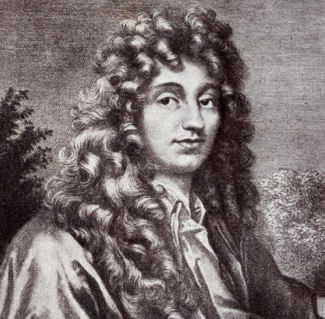 and physicist who, among others,
founded the wave theory of light, discovered the true shape of the rings
of Saturn, and invented the pendulum clock. He also tried to construct
an engine by making use of the explosive action of gun powder.
and physicist who, among others,
founded the wave theory of light, discovered the true shape of the rings
of Saturn, and invented the pendulum clock. He also tried to construct
an engine by making use of the explosive action of gun powder. Huygens was from a wealthy and distinguished middle-class family. From an early age, Christiaan showed a marked mechanical bent and a talent for drawing and mathematics. In 1645 he entered the University of Leiden, where he studied mathematics and law. In 1655 he visited Paris for the first time where his distinguished parentage gave him entry to the highest intellectual and social circles. He lived in Paris from 1666 to 1681. The earliest reference to a projection lantern we find in Huygens’ manuscript of 1659 (Oevres completes, vol. XXII). In a short, probably incomplete, list of his inventions is mentioned –la laterne magique- 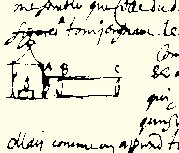 the magic lantern. We find more clues concerning the
activities of Huygens in connection with the magic lantern in the same part of his Oevres, page 197. This page shows
nine sketches, four of them encircled, from skeletons in positions of living people, with the caption:
“Pour des répresentation par le moyen de verres convexes à la lampe”
(To show by means of convex glasses on the lamp). Also the
correspondence with his friend, the French engineer P. Petit offers many
references to the magic lantern. November 28, 1664 Petit inquires after
the construction of Huygens’ lantern and its dimensions. This letter is
of special interest because it contains the oldest sketch of a magic
lantern that is known. Probably this is the lantern he used to project
the images of the skeletons. the magic lantern. We find more clues concerning the
activities of Huygens in connection with the magic lantern in the same part of his Oevres, page 197. This page shows
nine sketches, four of them encircled, from skeletons in positions of living people, with the caption:
“Pour des répresentation par le moyen de verres convexes à la lampe”
(To show by means of convex glasses on the lamp). Also the
correspondence with his friend, the French engineer P. Petit offers many
references to the magic lantern. November 28, 1664 Petit inquires after
the construction of Huygens’ lantern and its dimensions. This letter is
of special interest because it contains the oldest sketch of a magic
lantern that is known. Probably this is the lantern he used to project
the images of the skeletons. |
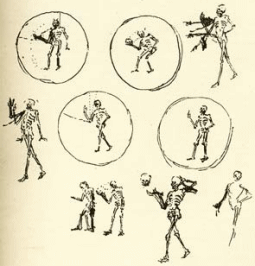
|
It's a remarkable fact that Huygens was not proud
of his invention at all. When his father, Constantijn sr., who was a
diplomat at the French Court, once ordered a lantern, he tried to
wriggle out of it. In a letter to his brother Lodewijk (1662) he
explains “……I feel ashamed that this way it will be known that
they come from me. People are kind enough to feign admiration, but later
on they will ridicule it, and not without reason.” Unable to get out of
it, he sends the lantern to
his father but asks his brother to sabotage it “by removing one of the
two lenses that are close to each other, such that only two lenses
remain, as there are three in total.” Asked for assistance he pretends
to have forgotten the construction of his lantern: “….. of which,
having removed the lenses long ago, I cannot remember what kind they were”. On the basis of the available data the conclusion is justified that Christiaan Huygens combined all the elements of a projection lantern, and also that he certainly did this no later than 1659. He must be considered to be the true inventor, though Huygens himself always tried to conceal the fact that the invention was his. |
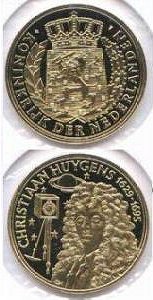
Gold coloured commemorative
token, 40 mm Ø, Legend: KONINKRIJK DER NEDERLANDEN (Kingdom of the
Netherlands), escutcheon with laurels. Reverse: CHRISTIAAN HUYGENS
1629 - 1695. Portrait with pendulum clock and celestial body. |
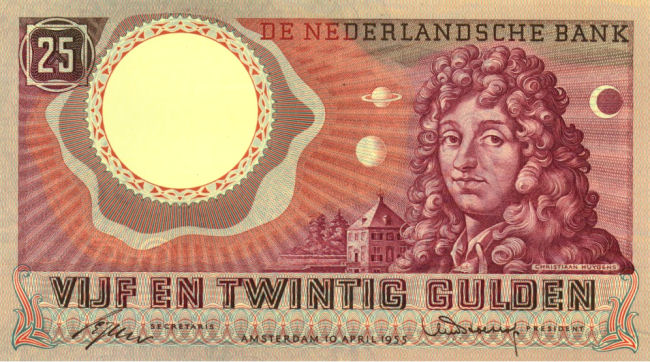 Huygens’ health was never good and he suffered from recurrent illnesses. The last five years of his life were marked by increasing feelings of loneliness and melancholy. He died July 8, 1695 in his birthplace The Hague. |
| |
©1997-2021 'de Luikerwaal' All rights reserved. Last update: 16-05-2021. |